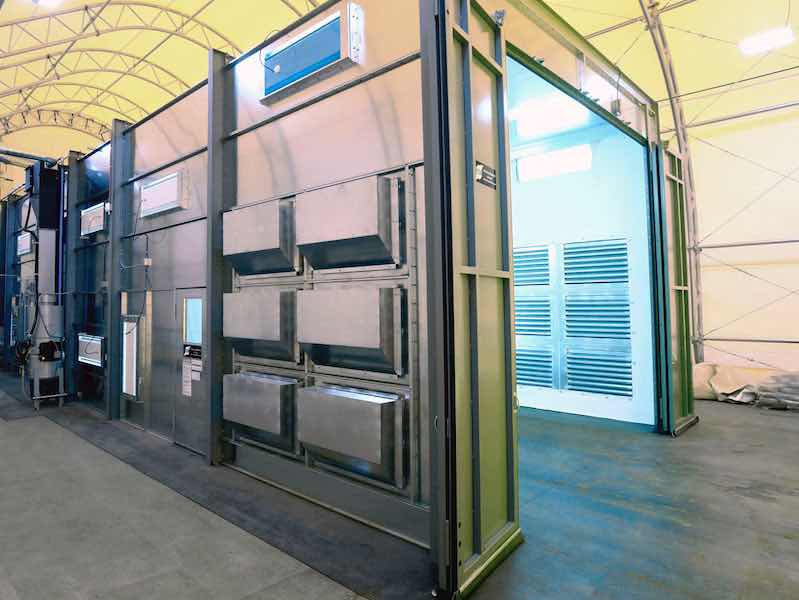You’ve spent a great deal of time and effort researching blast rooms.
 Brandon AckerYou’ve also done your due diligence and chosen the best abrasive blasting equipment to ensure a top-quality finished product. Now just throw in some ductwork, and your blasting operation is complete.
Brandon AckerYou’ve also done your due diligence and chosen the best abrasive blasting equipment to ensure a top-quality finished product. Now just throw in some ductwork, and your blasting operation is complete.
Not quite. The reality is that you need to put as much thought and research into selecting the proper ductwork as you did for the blast room and the equipment to perform the blasting. Ductwork cannot simply be an afterthought; in terms of choosing the optimal ductwork configuration for your abrasive blasting process for quality, performance, and durability, you shouldn’t just buy ductwork from your local home improvement store. It takes far more planning and evaluation than that.
Some companies have learned this lesson the hard – and expensive – way. As an example, a Titan customer had ordered a blast room and, in an effort to save time and money, decided to handle the ductwork themselves. So they went ahead, handling both the fabrication and the installation of this critical element.
The story does not have a happy ending. They ran into several issues, which delayed their blast room installation. The customer used light-gauge ductwork, typically used in HVAC systems, which quickly wore. They also had an abundance of 90-degree elbows, drastically reducing airflow and leaving the room cloudy with poor visibility. Instead of saving money, they lost money, plus the time that could have been spent blasting – proving that ductwork is not only something that shouldn’t be taken lightly, but it’s also not a DIY project.
There are numerous parameters that must be accounted for when choosing the ductwork for your blast room. Below are some of the most essential of these considerations – the ones that can become the difference between a well-constructed ductwork installation and one that fails to live up to expectations.
Abrasive Media Is ... Abrasive
It’s important to understand one of the most salient points about abrasive blasting: it’s abrasive.
“When dealing with blast rooms, you have to account for the roughness of the blast media that is being collected,” said Cole Dickens of US Duct, which manufactures ductwork for a wide variety of applications and processes, including industrial ventilation and dust extraction (both of which are critical in the abrasive blasting process). “Most of the media used in blast rooms is highly abrasive, so it’s vital to keep that in mind when choosing the material that will be used to create the ductwork.”
But the abrasive effect on ductwork goes beyond the material itself. “The level of abrasiveness is also determined by the speed at which the blast material is being conveyed and pushed through the ductwork, as well as the size of the pieces being collected,” he explained. “All these elements have to be factored in when determining the best ductwork for the application.”
Heavy Gauge Preferred
 Since most media employed in a blast room – along with the media dust it creates - is highly abrasive, it’s advisable to use ductwork made from heavy-gauge steel, compared to the light-duty ductwork common in wood and weld applications. The steel used for blast room ducting is much thicker than residential or commercial HVAC ducting.
Since most media employed in a blast room – along with the media dust it creates - is highly abrasive, it’s advisable to use ductwork made from heavy-gauge steel, compared to the light-duty ductwork common in wood and weld applications. The steel used for blast room ducting is much thicker than residential or commercial HVAC ducting.
For highly abrasive blast systems, Dickens noted that a thicker duct is recommended, at least 14ga duct or heavier (but typically 10ga or 12ga). While the heavy gauge is more costly than material in the 20ga -22ga range, it tends to be worth the added cost based on the superior durability – especially when blast material is moving at high velocity, which quickly destroys the thin material used for HVAC ducting.
Galvanized sheet steel ducting is used in most dust-collection applications. That’s because galvanized duct offers one of the most affordable ways to protect metals when compared to other protective coatings for steel. During the galvanizing process, zinc or another metal coating is applied to a dense base black metal, imbuing it with anti-corrosion properties that protect it from corrosion; thus, it will not become oxidized or corroded. There are other lining materials that can be used as well to help ductwork stand up to repeated abrasion by blasting dust.
Using the incorrect size (or diameter), ducting can speed up or slow down the airflow. This can lead to problems in both instances: if the blast material moves too slowly through the ducting, it won’t properly ventilate the blast room. Conversely, if it’s traveling too rapidly, the airflow becomes destructive due to the abrasive dust. Creating too many 90-degree elbows can significantly reduce airflow as well.
Dickens recommends using long-radius elbows instead of standard or short-radius elbows for highly abrasive applications. Long-radius elbows do not wear as easily; consequently, the life of the ductwork is prolonged. And since long-radius elbows offer less frictional resistance, they provide superior airflow to standard elbows. Additionally, a longer duct run will reduce the risk of fire by giving sparks time to cool before they hit the filter. If the process generates a large number of sparks and ductwork cannot be designed with a long enough run, a spark suppression system may be considered.
Measure Twice, Install Once
“Our customers are our ‘boots on the ground,’” said Dickens. “We rely on them to get us a layout of the system, and from there, we can design the ductwork system. This means not only supplying precise measurements to create the ductwork, but also information about any kinds of structural items such as sprinkler systems, overhangs, ceiling beams, and lights, not to mention the ceiling height itself.”
Because every blasting operation takes up differing amounts of space, there is no standard length of ductwork that needs to be used. That puts the onus of providing precise measurements on the company purchasing the ductwork, as well as making the company producing and installing the ductwork aware of any onsite challenges.
There are various methods for connecting the pieces of ductwork to the system – and to each other. US Duct offers a modular system that allows for easy field modifications to reduce install times by up to 70% compared to traditional bolt-together flanged ducts. We provide adjustable sleeves that allow the installer to cut the 5’ section to the desired length and use the adjustable sleeve to slide over the cut end of the duct and make quick modifications to the overall length of the duct.
If a high flow rate or certain materials are causing unwanted vibration, a vibration damper can be an effective remedy.
Another option is a bolt-together flanged duct, which features flanges - sometimes with holes - on either end. These flanges get bolted together, but the flanges must align perfectly in order to be connected, which can be time-consuming and leave little room for error. The other option is similar to the flanged bolt-together design, but instead of bolting the flanges together, the ends are welded. This requires a certified welder and can also be a long, laborious task, not to mention the difficulty of access, as most blast room ductwork is high above the floor.
If a high flow rate or certain materials are causing unwanted vibration, a vibration damper can be an effective remedy. Vibration dampers have standard connection ends with a heavy rubber material connection in between. This allows for vibration to be isolated to one section at the rubber joint, thereby preventing continued vibration further down in the system.
When dealing with noise issues from the fan or general airflow, silencers can provide a great solution. Silencers are perforated lengths of pipe enclosed by four inches of insulation. The resonation within the ducting is absorbed within the thick insulation, reducing sound by 10-15%.
Conclusion
While the function of abrasive blasting ductwork – conveying unwanted material out of the blasting area – is relatively simple, the process of identifying, purchasing, and installing the ductwork is not. Considering the significant investment you’ve made in your blast room, engaging the services of a professional supplier is a wise choice. Still, it’s extremely important that you know the basics of how a solid, dependable ductwork installation occurs. As with virtually any purchase you can make, an informed consumer is the best consumer.
Brandon Acker is the president of Titan Abrasive Systems, a leading manufacturer of abrasive blast Rooms, cabinets, and related equipment. Visit https://www.titanabrasive.com































